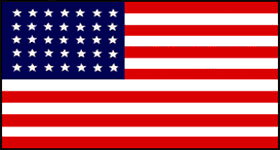 |
Civil War Battles |
|
State War Records |
| AL - AK - AZ - AR - CA - CO - CT - DE - FL - GA - HI - ID - IL - IN - IA - KS - KY - LA - MA - MD - ME - MI - MN - MS - MO - MT - NE - NV - NH - NJ - NM - NY - NC - ND - OH - OK - OR - PA - RI - SC - SD - TN - TX - UT - VT - VA - WA - WV - WI - WY |
The Battle of Droop Mountain
November 6, 1863 in Pocahontas County, Virginia
 |
|||||||||||||||||||||
|
On November 1st, Brig. Gen. William W. Averell with a 5,000-man force of Union infantry and cavalry departed southward from Beverly, West Virginia, into the Allegheny Mountains. two days later Brig. Gen. Alfred N. Duffie left Charleston, West Virginia with another 1,700 Federals. Ordered to wreck the East Tennessee & Virginia Railroad, these 2 raiding parties marched by seperate routes toward an assigned junction at Lewisburg.
Harassed by Confederate guerrillas and scouts, Averell's main body of 2 infantry, 4 cavalry regiments, and 2 artillery batteries followed the Staunton Pike to Greenbrier Bridge, then through Camp Bartow and Green Back to Huntersville, arriving there about noon on the 4th. At Huntersville, Averell learned that approximately 600 Confederate troops, under Col. William L. Jackson, were stationed at Marling's Bottom and immediately dispatched 2 cavalry regiments to cut them off. Jackson's men eluded the Union troopers, deploying at Mill Point. The next day, Averell carried out a similar movement, and Jackson retreated to the crest of Droop Mountain.
Jackson, a cousin of Lt. Gen. Thomas J. "Stonewall" Jackson, who was derisively nicknamed "Mudwall", had requested reinforcements on the 4th. The next day, as Jackson regrouped on Droop Mountain, Brig. Gen. John Echols left lewisburg with an infantry brigade and 6 cannon, reaching the mountain summit at 9:00 A.M. on the 6th. Assuming command, Echols deployed his force, his artillery anchoring the center and his infantry on the right. Jackson's cavalrymen held the left.
Averell, meanwhile, deployed for an assault, sending his infantry to the right in a circuitous march beyond the Confederate western flank. While the infantrymen ascended the mountain, the cavalry and artillery demonstrated against the Confederate center. An artillery duel ensued, while the Union flanking force, delayed by an inept guide, moved into position.
About 1:30 P.M., Averell's infantry charged into Jackson's dismounted cavalrymen. With the sound of rifle fireon the summit, the Union dismounted cavalry advanced up the face of the mountain. Behind crude breastworks of logs and stones, Echols 1,700 men clung to their position for over an hour. At 3:00 P.M., the Confederate line collapsed, its ranks retreating down the south side of the mountain. The Federals only captured 1 cannon and 1 battle flag. Content with the victory, Averell halted for the night.
The Union march resumed early on the 7th toward Lewisburg. Averell's advance entered the town at 2:00 P.M., finding Duffie already in possession. Duffie had had an uneventful march, reaching Lewisburg only hours before. The combined forces advanced the next day on Dublin, where Echols was reportedly reforming. Delayed by felled trees across the road and the condition of the troops, Averell, with Duffie's concurrence, abandoned the raid.
The 2 Union commands seperated for the return march, Duffie reaching Beverly on the 12th, Averell 5 days later. Little had been accomplished, for the Confederates reoccupied Lewisburg as the Federals departed. Averell had won a minor victory, captured some prisoners, stores, and livestock but failed to wreck the railroad, the raid's objective.
Droop Mountain Battlefield is the site of the last significant Civil War battle in West Virginia.
